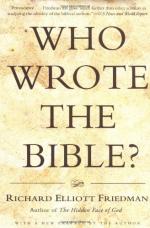
|
| Name: _________________________ | Period: ___________________ |
This test consists of 15 multiple choice questions and 5 short answer questions.
Multiple Choice Questions
1. What do scholars call two different versions of the same story?
(a) a repetition.
(b) a puzzle.
(c) a contradiction.
(d) a doublet.
2. What is the traditional belief about the authorship of the first five books of the Bible?
(a) that Noah wrote them.
(b) that Adam wrote them.
(c) that Moses wrote them.
(d) that Isaiah wrote them.
3. How has science corroborated the fall of Lachish?
(a) archaeology done at Tyre and Sidon.
(b) modern archaeological excavations at this site.
(c) carbon dating of rocks.
(d) discovery of scrolls mentioned in the Bible.
4. How long has the Bible been in existence?
(a) thousands of years.
(b) a millenium.
(c) five hundred years.
(d) two thousand years.
5. What does Friedman propose about Author J?
(a) that he was not a Hebrew.
(b) that he was a Levite.
(c) that he lived in Judah.
(d) that he came from Jerico.
6. Why is the authorship of the Bible a comparatively recent field of study?
(a) for centuries no one really read the Bible.
(b) for centuries the authorship was a guarded secret.
(c) for centuries the clergy accepted the pat answers.
(d) for centuries people never read the Bible.
7. During the time of Judah before Babylon, who initiates religious reforms?
(a) King Rehoboam.
(b) King David.
(c) King Saul.
(d) King Hezekiah.
8. What happened to the snake sculpture that Moses had built in the wilderness?
(a) copies were made for all areas of the kingdom.
(b) it was brought to the Temple.
(c) it was taken by the Assyrians.
(d) Hezekiah destroyed it.
9. Oddly enough, where do the Judeans flee when under attack by Assyria and Babylonia?
(a) Shiloh.
(b) Egypt.
(c) Midian.
(d) the wilderness.
10. What is seen in the Author E story of Jacob's blessing of his sons and grandsons?
(a) it has the tribes asking for a king.
(b) it only includes the northern tribes of Israel.
(c) it mentions only two tribes.
(d) it includes all the tribes that make up Israel.
11. What do Henning Bernhard Witter, Jean Astruc, and Johann Gottfried Eichhorn have in common?
(a) they concluded the two author idea about the same time.
(b) they all came from Germany.
(c) they were all burned at the stake for heresy.
(d) they all disclaimed the two author idea.
12. Why did one write become designated Author J?
(a) he never refers to Jehovah in his writing.
(b) his first name was Johan.
(c) he always refers to God as Elohim.
(d) he always refers to Yahweh in his writing.
13. What were the cherubs inside the Holy of Holies?
(a) statues of baby angels carrying bows and arrows.
(b) two statues of a four-legged animals with wings and the heads of humans.
(c) abstract statues of angels.
(d) statues of golden calves with wings.
14. What is the status of Aaron in the narrative of Author E?
(a) it is hero status.
(b) it is sinful status.
(c) it is insignificant status.
(d) it is objectionable status.
15. What observation did Thomas Hobbes make about certain language in the Bible.
(a) phrases like "to this day" could only come from God.
(b) the language indicates little change in usage.
(c) phrases like "to this day" are used to talk about the past.
(d) the language is unquestionably uniform.
Short Answer Questions
1. Why did Author E get his designation?
2. What symbol in Exodus parallels a similar object in the northern kingdom?
3. What did Solomon build that was larger than the Temple?
4. To what do the books of the Early Prophets bear a remarkable similarity?
5. What innovation does the reformist King introduce?
|
This section contains 616 words (approx. 3 pages at 300 words per page) |

|




